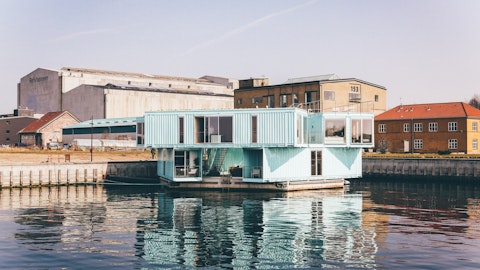Matthew J. Flannery: Yes, it’s pretty broad. I mean we have different maturity levels. But you could imagine, whether it’s a reliable on-site business, right, affordable sensation, some of the additional products that we’re adding to our Power HVAC team and the mobile storage, right, as part of that continued footprint. Rollout would be the three largest areas, ironically, not trench. Trench is continuing to get penetration, but don’t necessarily need geographic distribution growth for their penetration. So all — as I said in my opening remarks, all the specialty businesses, all those product lines grew by double-digits in the quarter. So we’re really pleased with that continued headroom for growth in specialty.
Jerry Revich: Thank you very much.
Matthew J. Flannery: Thanks Jerry.
Operator: Thank you. Our next question comes from Michael Feniger with Bank of America. Please go ahead.
Michael Feniger: Yeah, thank you. Thanks for taking my question. Matt and Ted, if we look back at the last big downturn in construction, after rates were cut it took some time for nonresidential to really come back. Do you believe your portfolio of business mix and the environment is different now, if we see some easing of financial conditions, how do you see that kind of flowing through your business mix with MRO exposure, different verticals, versus maybe the path or is this a much more gradual longer recovery?
Matthew J. Flannery: So I’ll start with, I don’t pretend to be an economist, right, or an expert forecaster. But when we think about what the impacts could be of the Fed easing rates, we’ve seen slower growth in the local market business. We’re very pleased that it’s still growth. And as we said, pretty broad-based growth in Q4 as we exited the year but not double-digit growth opportunity out there. And that’s why you see our guidance as it is. We feel while this transition of maybe that local market pipeline of business starting to be built out and funded, as interest rates lower that’s our future growth. As we go forward we’re very pleased, and we’ve been talking about for a while that the five tailwinds that we’ve been trumping throughout 2023 as a way to hedge against some of that slower growth in the local market has allowed us to come out with 2024 being a growth year.
That’s always been our thesis how it plays out, Michael. We’re not experts in that, but we do talk to our customers. The majority of our customers surveyed in our customer confidence index continue to feel positive. So I don’t want to paint a picture that there’s negative growth or that we have problems in the local market. It’s just not what it’s been for the last couple of years, and we do think it will ramp back up once the Fed takes their actions. The pipeline will take a little while to fill, but we don’t really have the ability to forecast how long.
Michael Feniger: Right. Great. And Matt, just a follow-up. I mean you just delivered $2.3 billion of free cash flow in 2023. You’re guiding another $2 billion in 2024. In a year that you’re saying it’s a transition year and you’re still investing in the fleet, is it safe to say that the new baseline free cash flow level for URI going forward is this $2 billion marker. I mean 2024 is a transition year, 2025 you still see some growth. Like any reason why we shouldn’t be thinking that maybe this $2 billion line is kind of a new baseline going forward?
William Ted Grace: So, I’m thinking through this, Mike only because we’ve never really kind of given that kind of guidance. So I want to think through and give you a more thoughtful answer. I mean you’ve heard us long saying we feel great about the cash generation characteristics of our business. We tend to frame things more as a function of normalized free cash margin and I think certainly, if you were to apply that kind of construct to reasonable outlook, again, I hesitate to kind of give you kind of numbers. But I think we feel comfortable that what you’ve seen us do historically in the recent history is something we can continue to sustain.
Matthew J. Flannery: Yes. I would agree. And Ted just said he doesn’t want to make sure — he doesn’t want us to be given a five to 10-year future cash flow forecast, and I don’t disagree. But I think the way you’re thinking about what’s been the evolution of the business and the change in the business is something we talked about a while back about driving positive free cash flow through the cycle. And I feel like we’ve been proving that out. And I agree with Ted’s sentiment and the sentiment of your question, we’re just not going to forecast that all the way.
Michael Feniger: Fair enough. And just last one to squeeze in, just with your guidance around CAPEX disposal, just what — where is — how do you feel with your fleet age right now, where it’s going to end this year relative to where you guys were maybe pre-COVID that would be helpful? Thanks everyone.
Matthew J. Flannery: Yes, it is a great question. We actually feel really good about where the fleet age is. I think we’re technically at — we’re just over 52 months right now. But when you adjust for tanks, mobile storage, some of the longer-lived assets that we’ve mixed into the fleet, we look at this from a mix perspective, we’re back to pre-COVID levels. So we’re back to a healthy level of fleet age. It doesn’t mean that we still don’t want to refresh and keep turning some of the assets. But net-net, we feel really good about where we are and back to pre-COVID levels when you adjust for mix of fleet.
William Ted Grace: And that will improve further in 2024, right. And the easiest way to think about this mathematically, is we’re going to buy $3.5 billion of CAPEX, just playing with really simple assumptions. Midyear convention would say that six months on average, we’re going to sell $2.5 billion of fleet that you can assume is 90 months old on average. So just — you can just see how that would imply mathematically, how you’re going to kind of re-age down further. So again, to Matt’s point, 52 nominally kind of back to pre-COVID levels in the upper 40s adjusting for those acquisitions, and it’s going to get a little better. So it gives us, it gets back to that strength of the balance sheet, strength of the fleet, gives us a lot of optionality.
Operator: Thank you. Our next question will come from Tim Thein with Citigroup. Please go ahead.
Timothy Thein: Or Tim Thein, whichever. I like that one. Matt, back to your comment about fleet productivity, when you — I think when you came out with that construct, the goal was — the target was to be able to outrun inflation. Do you think, I know you don’t guide quarterly, but should we be thinking about that number in excess of inflation each quarter or will that — is that too much of a — the seasonality and other factors pose too much of a challenge on that?
Matthew J. Flannery: You should think about that our goal as it is, is to exceed that 1.5 target every quarter. Whether we achieve it or not, right, even if you look at our pro forma this past year, which is how we looked at it, we actually did achieve that this past year. So we get — we didn’t as a reported level, but we did from a pro forma, which is how we kind of manage the business. So that’s our goal, that’s what we’ll be marching towards. And we think the end market is conducive to doing that.




